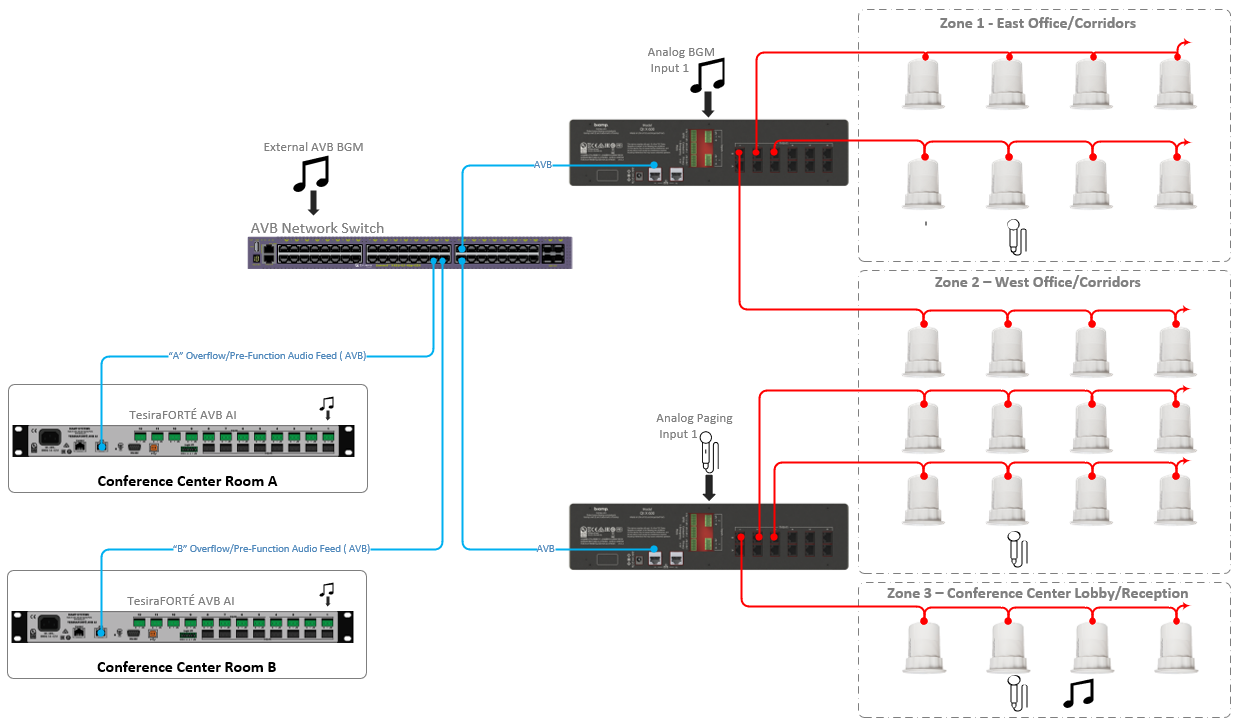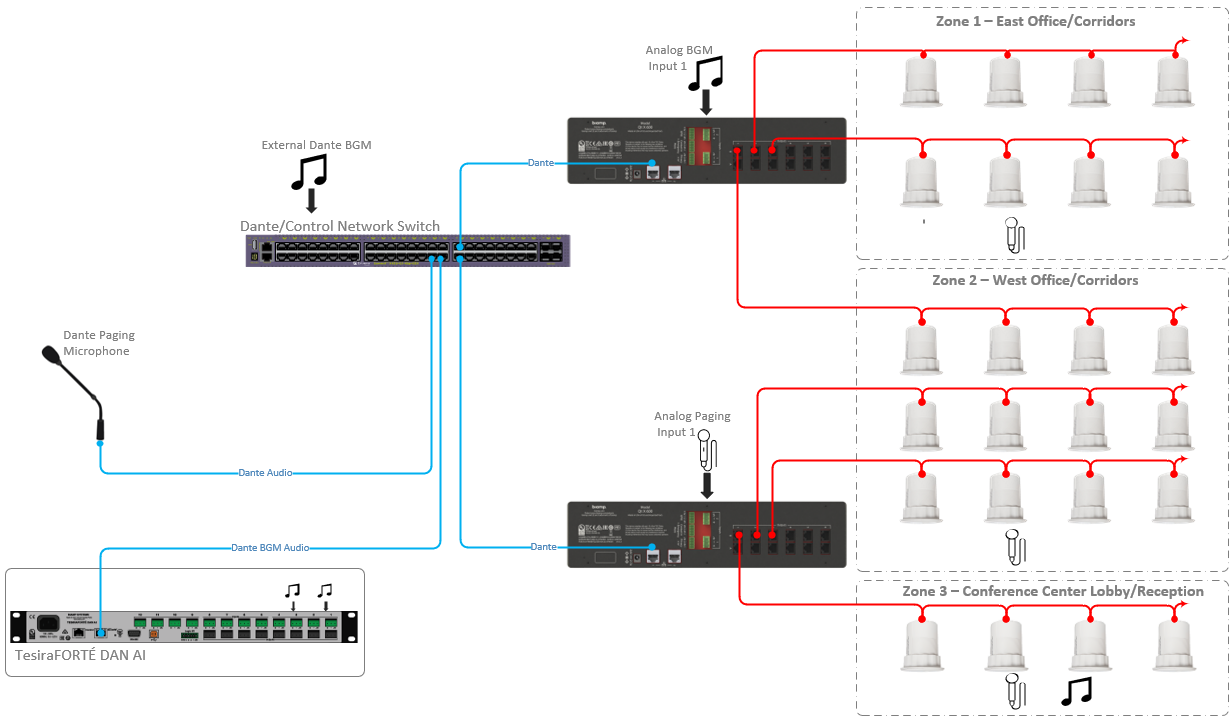Qt X AVB and Dante media networks
This article describes the supported media network topologies required when interfacing Qt X hardware with external sources for bgm or paging. The Qt X series is available in eight models and supports AVB and Dante media networks making building-wide paging and music distribution flexible and simple.
Overview
Qt X devices support the use of common Ethernet network-based features to facilitate integrating audio in an AV environment. Depending on the hardware, network port functions are either separate or combined. Qt Xes have RJ45 Gigabit Ethernet port connectors supporting AVB or Dante media streams. Models with the "D" variant in the model number provide support for either AVB or Dante media transport.
Multiple controllers can be included in a system setup, allowing for shared sources from external AVB or Dante sources to be available to any common assigned zone. All controllers within a single system must be configured to use the same networked audio transport type. Digital audio inputs are routed to specified zones regardless of controller input or output location.
Qt X design software allows all masking and analog sources to use the Qt X internal transport protocol to route audio between devices within a configured system. In systems where external AVB or Dante is required, routes or streams are set up by name in the Qt Software or Web UI to eliminate the requirement for third-party routing software.
- 6 networked media inputs (AVB or Dante) per Qt X processor.
- When multiple Qt X controllers are included in a single system audio inputs can be shared across all controllers via AVB or Dante(300D//600D/800D805D).
AVB devices will only support AVB. Dante devices are configurable for Dante or AVB

Media Types
Dante devices can be reconfigured to AVB with simple selection and reboot after changing the media type under the device's Network tab.
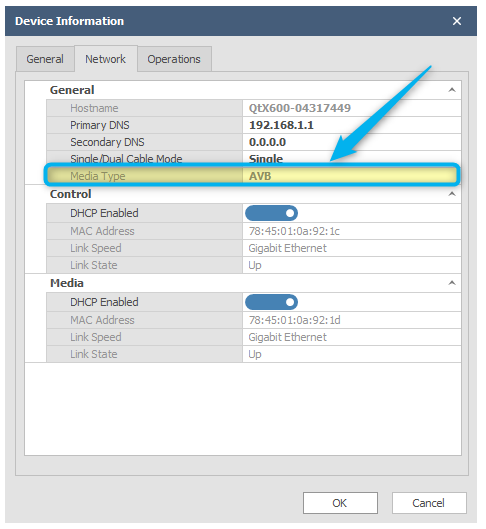
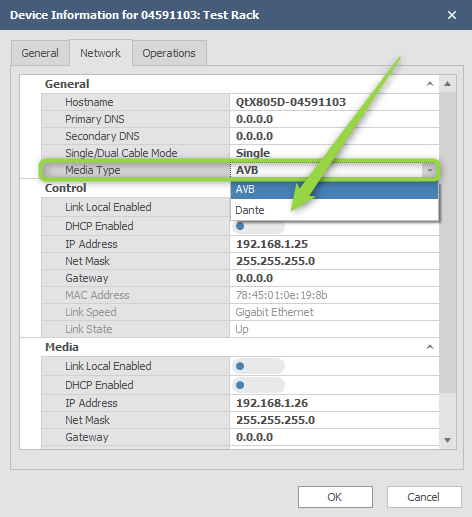
Note: Media type may only be changed while a device is cleared of its configuration. To clear and active configuration, select from the systems tab and select "clear configuration".

Network Interface Overview
A Qt X system can support the following network interfaces:
-
Control Network Interface
-
AVB (Audio-Video Bridging) Interface
-
Dante Interface
LAN 1 – Control/Media network (Supports AVB or Dante) LAN 2 – Control network
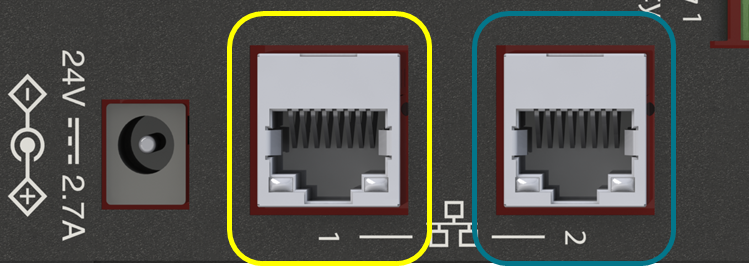
Single Cable Mode
Control network and Media network are combined using the same network infrastructure. Both Media and Control information share the same switch port. In this mode the #2 port is disabled. Note: (2) IP and MAC addresses are seen on LAN 1 while in single cable mode.
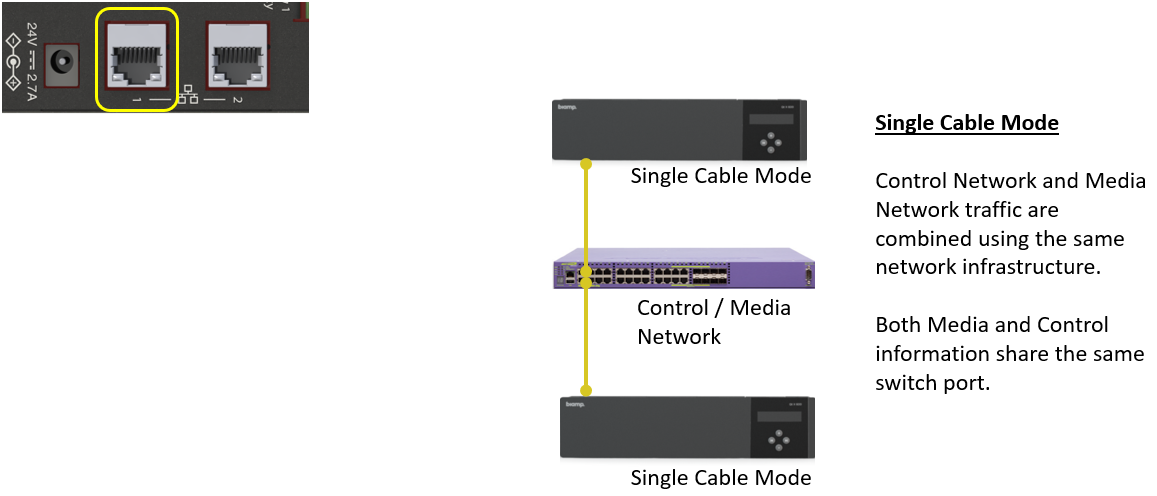
Dual Cable Mode
Control network and Media network traffic are on different networks.
- Control from an enterprise network for management.
- Media is physically on a separate network.

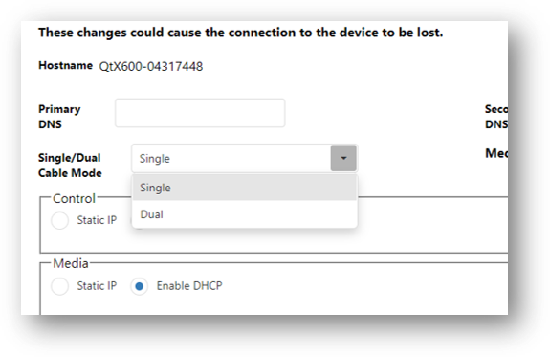
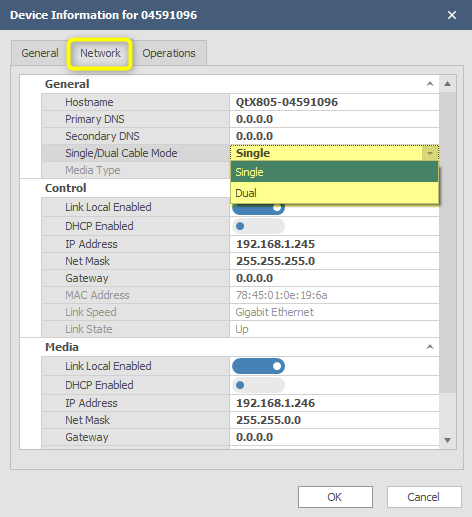
Selecting Single or Dual cable mode allows one port to handle all control and media communications (single cable mode) or to separate the media and control ports (dual cable mode), based on user and system design preference. While in single cable mode, the media network IP address is assignable to match other devices if required. This can be set to DHCP while keeping the control IP at a static address if required for further flexibility.
Note: In Dual Cable mode using only two controllers in a configuration, it is possible to directly connect the Media ports between without the need for an additional switch. It is still necessary to connect each control port to control switch for loading a configuration to the system.
DHCP is checked by default and allows the automatic assignment of an IP by a DHCP server. Link local enabled is also on by default, allowing the hardware to self-address if a DHCP server is not present. If users select Static IP, they will have the option to configure the device network settings as needed.
The Network Settings tab allows users to modify the primary DNS, add or modify the secondary DNS, and allows configuration of the Control and Media ports. Users may also switch between single and dual cable modes. The media type will only be changed to Dante if a Dante-enabled device is connected.
The left RJ45 control port on the Qt X 800/800D is specifically configured for PoE+ connection.
Note: Factory reset hardware will return network settings to DHCP enabled, Link Local enabled, and Single Cable mode. Qt X (D) variants will factory default back to Dante as the media type.
Comparing AVB and Dante
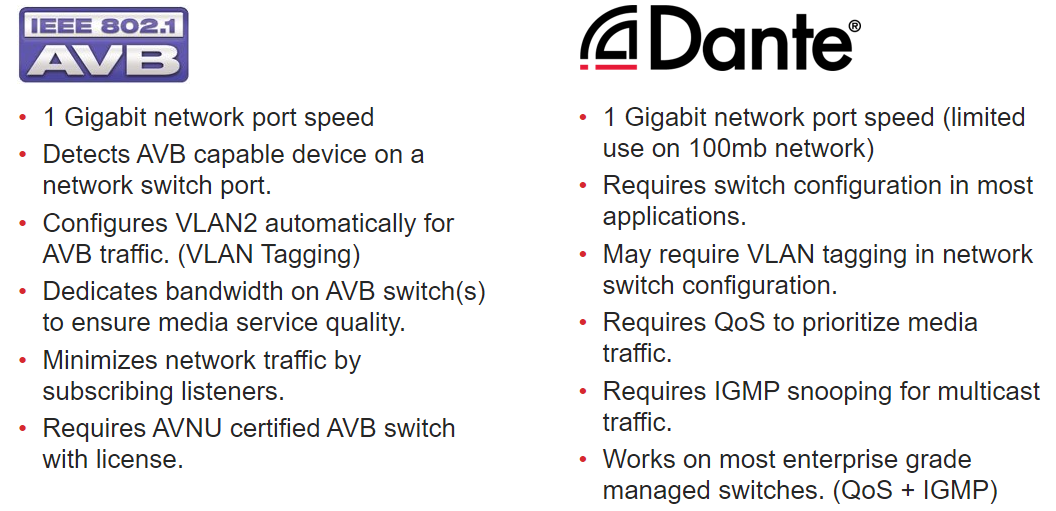

AVB media networks for Qt X
AVB-capable Qt X controllers can share resources via "implicit" AVB streams. These are created when the file is loaded to the processors and allow any zone resources to share across the media network. No additional steps or routing are required to distribute audio across zones. A licensed AVB-capable switch is required for IEEE 802.1 traffic to pass between Qt X devices.
Note: Qt X controllers have a default peer delay value of 1200ns. If Fiber media converters are used to extend from core switches to Qt X field devices it is recommended to increase this value to resolve any AVB clocking errors.
AVB Networks Review
- “Streams” contain a number of channels. Up to 64 Streams are available.
- An AVB “stream” can contain up to 60 channels per stream.
- Qt X with AVB enabled has 6 explicit single channel “streams”. Or put differently, 6 media channel inputs per processor.
- Clocking is managed by a network switch for latency.
- 2ms Latency Maximum
Single Cable Example: Shared analog and media resources across single cable AVB network
In the example above, the 3 available zones can analog, or AVB source inputs regardless of the input location. All media traffic between Qt X controllers is handled over AVB to allow for a source that was a physical input at one controller to be available at any other controllers within the system. These sources all show up after being added to the configuration and are available to assign to any of the programmed zones in the Qt X software layout. In the shown routing, masking and paging signals feed to the Office and Corridor areas while the Reception and Conference Center Lobby have masking, BGM music, and paging available.
AVB Ports and protocols
Biamp's Qt x products use a variety of network protocols to carry out their functions, and those protocols operate on a wide range of network port numbers. Network administrators often need to know the list of ports that a device might use to communicate over the network.
Depending on network configurations in the Qt X setup, the Qt X AVB ports may also utilize the Control NIC protocols as detailed elsewhere.
| Port | TCP / UDP | Protocol | Notes |
|---|---|---|---|
| 17720 | UDP | IEEE1722 | AVB Transportation Protocol (AVB Streams) |
| 17721 | UDP | IEEE1722-1 | AVDECC Discovery Protocol / Enumeration and Control Protocol |
AVB Propagation Delay setting
When using Media converters with Qt X endpoints over fiber, it is sometimes necessary to adjust the Propagation Delay or pDelay to a range longer than the default of 1200ns.
 The length of the fiber line and media converter will have an impact on propagation delay. If the link propagation delay exceeds the peer delay threshold, AVB clocking will not function correctly and ports will report AS-incapable. Both the switch and Qt X controller(s) must have their peer delay threshold configured to account for the media conversion.
The length of the fiber line and media converter will have an impact on propagation delay. If the link propagation delay exceeds the peer delay threshold, AVB clocking will not function correctly and ports will report AS-incapable. Both the switch and Qt X controller(s) must have their peer delay threshold configured to account for the media conversion.
Qt X software and firmware version 2.4 and later will have an available pDelay setting accessible via the Qt X software Network tab.
AVB Propagation Delay Threshold
Changes to the default value (1200 ns) should also be replicated on the associated network switch. Available range: 800 - 10000 ns
Note: AVB propagation delay setting is not available via the Web UI.
Dante Media Networks for Qt X
Dante
Qt X Dante "D" enabled models support network media connectivity with Dante audio devices via the LAN 2 port. Qt X controllers that are Dante capable have the ability to share resources via "implicit" Dante streams. These are created when the file is loaded to the processors and will allow any zone resources to share across the media network. Dante controller routing is not required for media network flows between Qt X controllers.
External Dante sources may be added as a selectable input source to a Qt X controller. When this feature is used, the input source must be routed in Dante controller to its desired receiver device. More info on this process is available in the Qt X Programming for Dante Audio Sources article.
Dante is using Unicast flows throughout, The Dante flows are dynamically set to single / two channels as necessary based on subscription. A controllers output flows may be "Streamed" to multiple listeners using unique Unicast flows which are visible in Dante controller.
Dante Networks Review
-
1 Gigabit network port speed (limited use on 100mb network)
-
Requires switch configuration in most applications.
-
May require VLAN tagging in network switch configuration.
-
Requires QoS to prioritize media traffic.
-
Requires IGMP snooping for multicast traffic.
-
Works on most enterprise-grade managed switches. (QoS + IGMP)
Dante Networks with Qt X Controllers
-
“Flows” contain a number of audio channels. There are up to 32 flows.
-
A Dante “flow” can contain 1, 2, or 4 channels (unicast) per flow.
-
Qt X with Dante enabled uses 8 single channel “Flows” in. (8 media channel inputs per processor).
-
Qt X with Dante enabled has 32 single/dual channel Dante “Flows” channels for output. (2 media channel outputs per processor)
Additional Dante details are available on our Dante support page.
System topology example: Shared Analog and Dante resources across a single cable Dante network.
In the example above, the 3 available zones can share any of the analog or Dante source inputs regardless of the input location. All media traffic between Qt X controllers is handled over Dante to allow for a source that was a physical input at one controller to be available at any other controllers within the system. These sources show up after being added to the configuration and are available to assign to any of the programmed zones in the Qt X software layout. In the shown routing, masking and paging signals feed to the Office and Corridor areas while the Reception and Conference Center Lobby have masking, BGM music, and paging available.
Dante ports and protocols
Dante-capable Qt X models only, Gigabit Ethernet (1000Mbps), Position 1 – Dante media network port
| Port | TCP / UDP | Type | Notes |
|---|---|---|---|
| 8850 | UDP | Unicast | Via control & monitoring (Internal) |
| 38900 | UDP | Unicast | DVS control & monitoring (Internal) |
| 8899 | UDP | Unicast | DVS control & monitoring (Internal) |
| 8000 | UDP | Unicast | Dante Domain Manager Device Port |
| 8001 | UDP | Unicast | Dante Millau Device Proxy (Internal) |
| 8002 | UDP | Unicast | Dante Lock Server |
Audinate Dante port allocation can be found here https://www.audinate.com/faq/which-network-ports-does-dante-use
Multiple Switches
Qt X controllers can share media traffic across switches that span a larger network topology. This allows for logical arrangement of controllers per floor area, or by building. When using more than one AVB switch, considerations need to be made to the switch capabilities to handle media traffic over Fiber and copper uplinks between switches.
It is also important to consider the network radius and switch hops required for the design. The network radius is defined as the path from the two farthest points on a Local Area Network (LAN). The radius/number of devices present determines network latency. AVB = Maximum 2ms / Dante = Maximum 5ms
It is generally recommended that no more than 9 hops exist between the furthest edges of the AVB network when using a 1G network. The typical default latency for a Dante device is 1 ms. This is sufficient for a very large network, consisting of a Gigabit network core (with up to 10 hops between edge switches) and 100 megabit links to Dante devices. Smaller, Gigabit-only networks can use lower values of latency (down to below 200µs). Recommended latency settings are displayed in Dante Controller.


